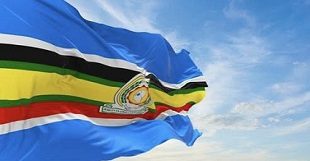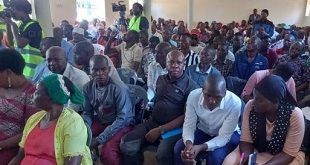
Gulu, Uganda | THE INDEPENDENT | When Nighty Akello’s 11-year-old daughter started complaining of pain in her stomach last year, she took it for a mild condition that would disappear in just a matter of days.
Akello, a resident of Koch Akili village in Kochgoma sub-county, Nwoya district says that her daughter had been living healthy until November 2021 when a swelling on her left lower stomach started affecting her.
Curious to know the source of the swelling, Akello took her daughter to a clinic in her village but a nurse in charge told her that she couldn’t diagnose internal complications and referred her to Koch Goma Health Center III.
From Koch Goma Health Center, she was further referred to St. Mary’s Hospital Lacor in Gulu City for an ultra scan to establish the condition.
The scan conducted from St Mary’s Hospital Lacor on November 17 revealed a worrying state of her daughter’s health as two different swellings were discovered on both sides of her stomach.
When blood samples were taken and referred for further testing at the Cancer Institute at Mulago, it turned out that Akello’s daughter had cancer. She was diagnosed with Wilms Tumor, cancer that primarily affects children’s kidneys. This wasn’t the news she had expected about her child’s health.
Akello, who has now spent nine months at St. Mary’s Hospital Lacor with her child undergoing treatment isn’t alone. Dozens of other parents and guardians of children diagnosed with various types of cancer from different parts of Northern Uganda and across South Sudan have flocked the facility seeking treatment.
Medics in the region reveal that there is a sharp rise in cases of childhood cancer and worry that the late detection could see high mortality from some treatable cancer diseases. Dr. Venice Omona, the head of the Pediatric department at St. Mary’s Hospital Lacor told Uganda Radio Network in an interview that Burkitt’s Lymphoma remains the most widespread cancer being registered in the region.
Burkitt’s Lymphoma is a type of children’s cancer that affects the lymphatic system. He notes that between January and August this year alone, they registered 83 children at the facility suffering from cancer. Twenty-five of these were cases of Burkitt Lymphoma followed by Wilm’s Tumor. According to Dr. Omona, although most childhood cancer causes are not known, there is a proven scientific study that associates malaria prevalence with endemic Burkitt Lymphoma.
He says to ensure a reduction in the cases of Burkitt Lymphoma, there is a need for individuals, stakeholders, and the government to focus on the prevention of malaria through the use of insecticide-treated mosquito nets, vector control, and indoor residual spraying.
Dr. Omona believes that the high numbers of cancer cases being registered are not an indication of a rise but the progress of sensitization that has seen many parents turning up with their children for treatment from the community.
Omona says although some cancer patients can be managed at the hospitals in the region, complicated cases are normally referred to the Uganda Cancer Institute in Kampala. He however notes that late detection and non-adherence to treatment remain a big challenge. At least 41 patients according to Dr. Omona succumbed to the disease last year.
Statistics from the facility indicate that so far, 191 children were diagnosed with cancer at St Mary’s Hospital Lacor between January 2021 and August this year. Sixty-seven of these were cases of Burkitt Lymphoma.
Due to the high cost of cancer treatment and its lengthy duration, some patients in the past according to Dr. Omona have abandoned treatment. This has however been addressed since the intervention of Soleterre, a non for profit organization that has partnered with the Pediatric Department at St. Mary’s Hospital Lacor.
Patra Joyce Laker, the Monitoring and Evaluation Officer (M&E) at Soleterre says since 2016, the organization has been able to provide family homes for guardians and parents of children undergoing cancer treatment at the facility. Laker says the facility has been established to accommodate the parents and guardians of the children who wouldn’t be able to afford to rent within the city while waiting for their children’s treatment.
She also notes that they have been offering economic support in form of transport to parents to enable them to return their children for treatment, bereavement funds for families who lose children, and funds for early detection and diagnosis support.
Laker says since 2016, they have enrolled 392 children diagnosed with different types of cancer at the family home, the majority of the patients being Burkitt’s Lymphoma at 188. James Lokiri, whose four-year-old daughter was diagnosed with Burkitt’s lymphoma is among the beneficiaries of the family home.
Lokiri, a primary school teacher who hails from Kajo Keji in South Sudan has now spent three months at St Mary’s Hospital Lacor and says he wouldn’t have made a long stay if it weren’t for the support from Soleterre. At the family home, Lokiri and her daughter like many other patients are provided with a full meal every day.
According to Moses Okello Rubangangeyo, a Medical Social Worker at Soleterre, the bulk of Burkitt’s Lymphoma cases registered at their facility are from swampy areas in Lango sub-region followed by West Nile sub-region and a few from Acholi sub-region. He says the areas are known to have a high prevalence of malaria.
Other cancer types that remain a burden to children in the region include Wilm’s Tumor, Rabdomyo Sarcoma, Non-Hodgkin Lymphoma, Hodgkin Lymphoma, and Kaposi Sarcoma. At least 170 children who were enrolled at the family home at St Mary’s Hospital Lacor have succumbed to cancer since 2016 according to data from Soleterre.
Uganda registers approximately 1,650 new cases of childhood cancer annually but the mortality rate reaches around 80 percent. Medics attribute the high mortality rate to limited specialized health facilities and skilled personnel, high treatment costs, and a lack of adequate treatment among cancer patients.
*****
URN
 The Independent Uganda: You get the Truth we Pay the Price
The Independent Uganda: You get the Truth we Pay the Price


